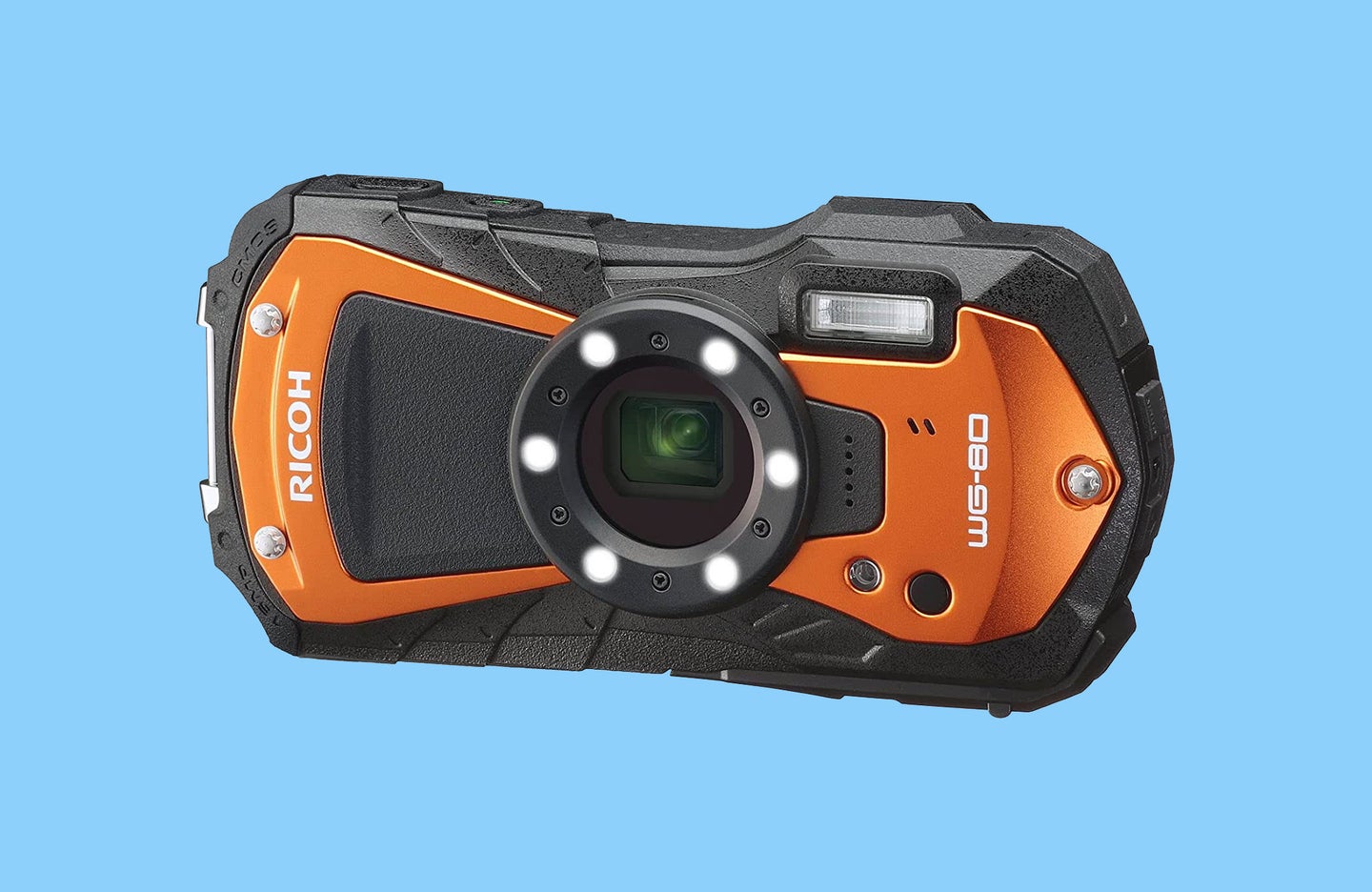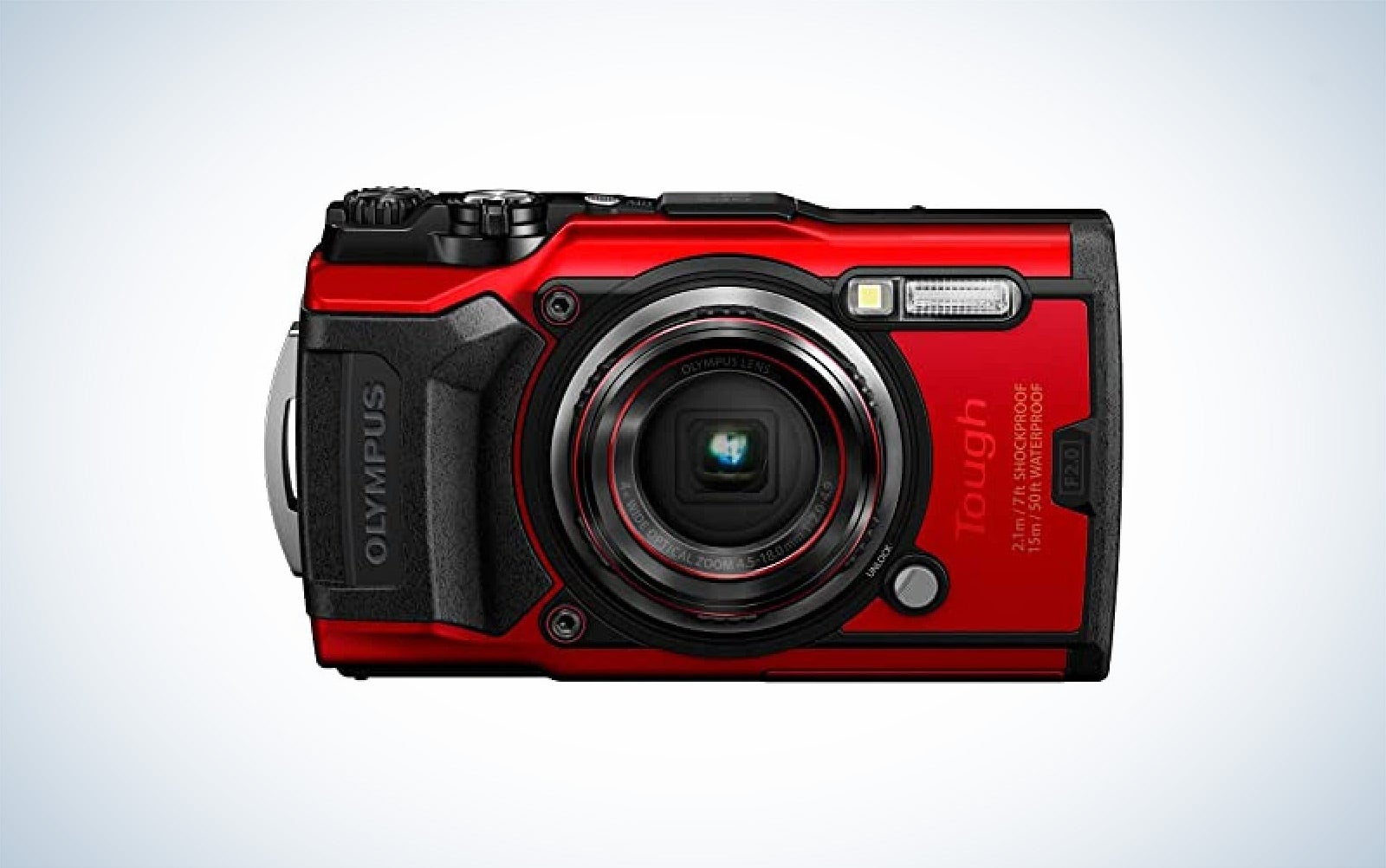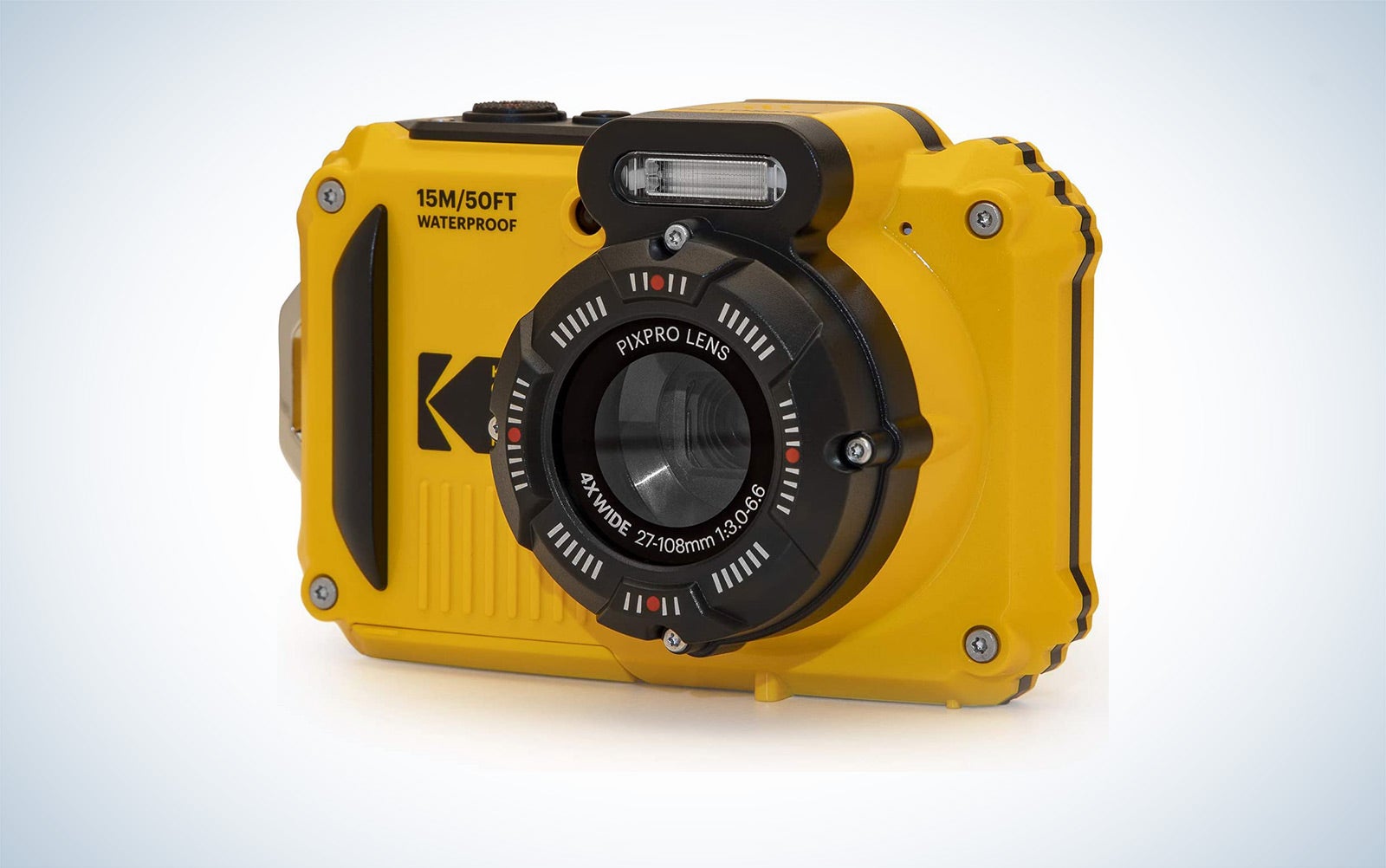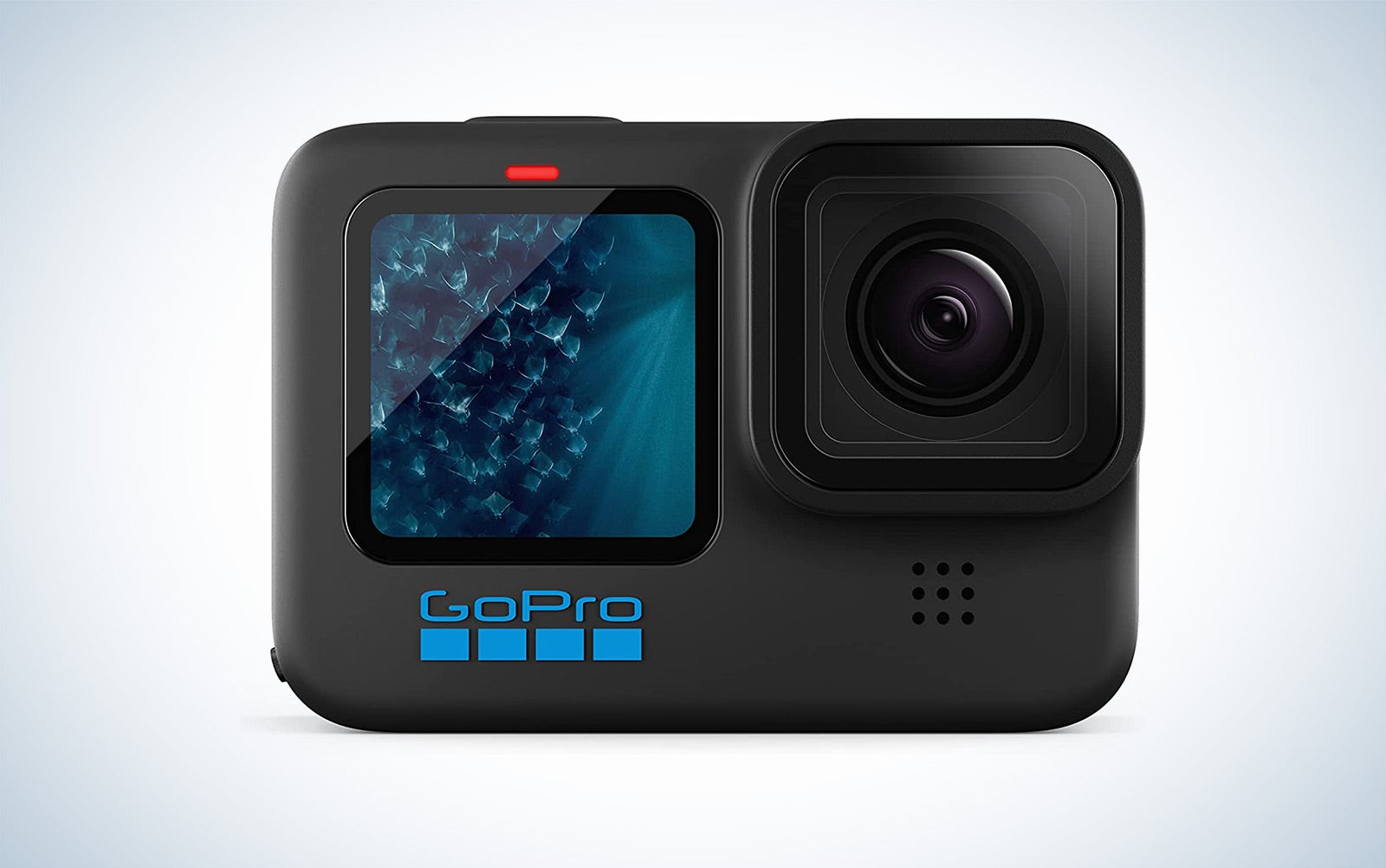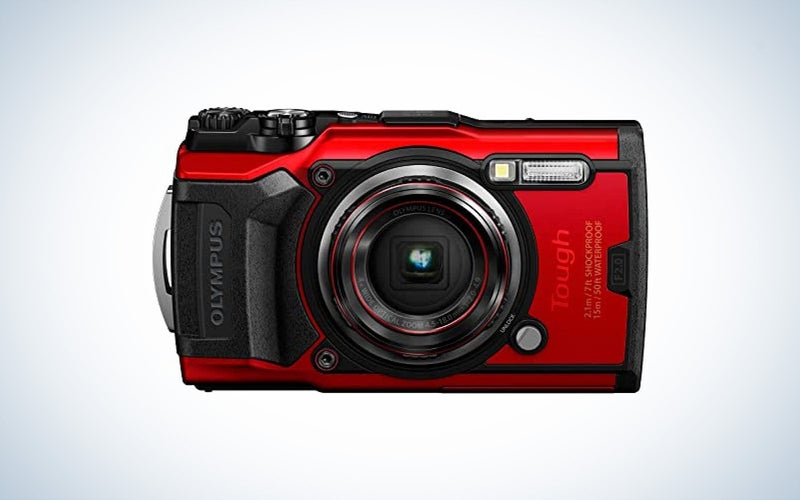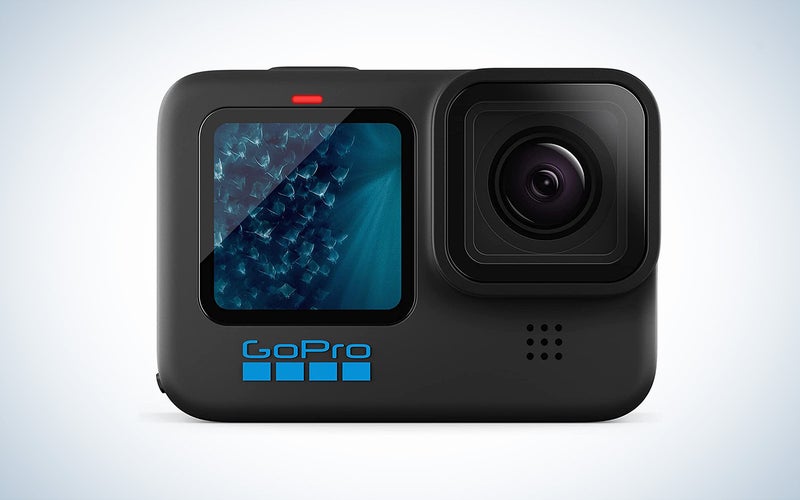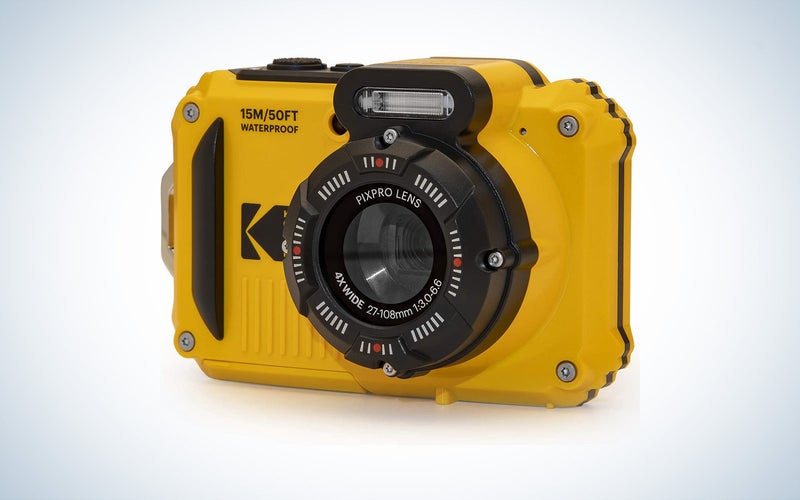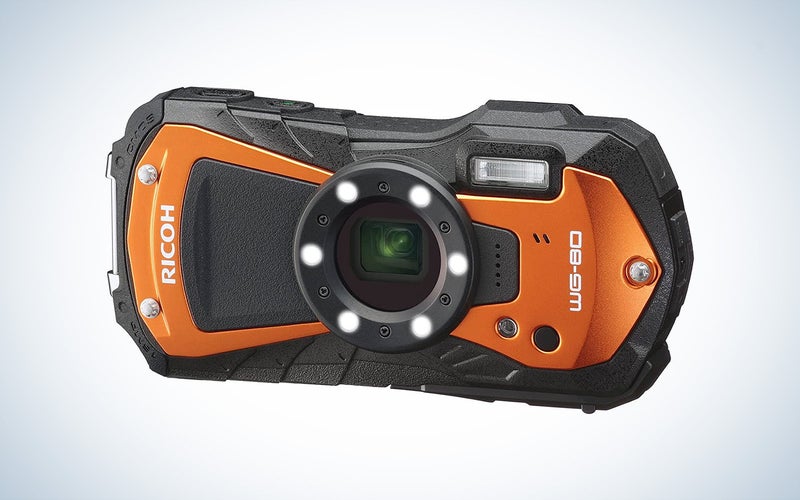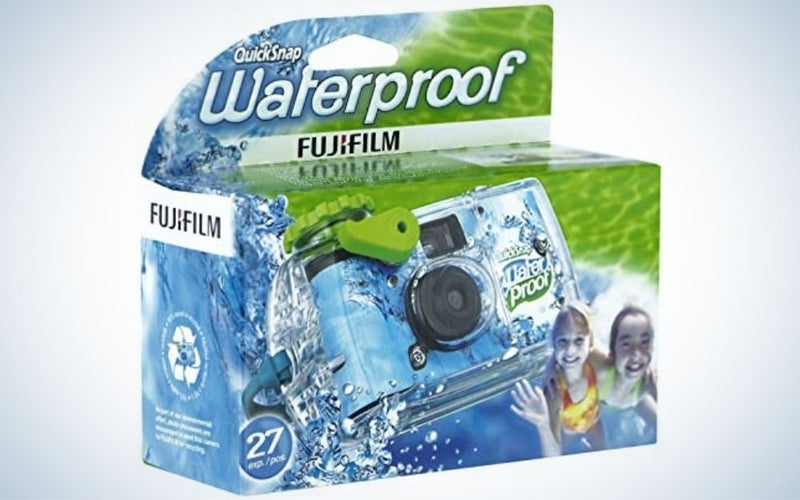We may earn revenue from the products available on this page and participate in affiliate programs. Learn more ›
Waterproof cameras are typically compact and incredibly rugged. They make an excellent choice for capturing memories in the great outdoors without any stress or worry. Although most DSLRs and mirrorless cameras have some level of weatherproofing, and smartphones have gotten much better at standing up to a bit of moisture, none are truly waterproof.
So if you’re looking to capture underwater images or shoot in a location where you and your gear are likely to get drenched, a dedicated waterproof camera is the way to go. Whether your travels take you to the beach, the lake, or even a weekend on the slopes, the cameras below will stand up to the task and fit a wide variety of budgets.
- Best overall: Olympus TG-6
- Best action cam: GoPro Hero 11
- Best for kids: KODAK PIXPRO WPZ2
- Best budget: Ricoh WG-80
- Best disposable camera: Fujifilm QuickSnap Waterproof Camera
Methodology: How we picked the best waterproof cameras
When selecting the cameras in this guide, we considered the locations where photographers might use the cameras, the types of footage they will capture, and budget. It was important to select cameras that fit various budgets and could be used underwater without additional underwater housing.
Best waterproof cameras: Reviews & recommendations
Best overall: Olympus TG-6
Olympus
Why it made the cut: The Olympus Tough TG-6 is a pocket-sized point-and-shoot that’s waterproof, freezeproof, shockproof, and crushproof. It’s a perfect camera companion for capturing all your adventures.
Specs
- Photo resolution: 12MP
- Video resolution: 4K 30p
- Size: 4.45 x 2.6 x 1.28 inches
- Weight: 8.92 ounces
Pros
- Very rugged
- Good video quality
- Compact
Cons
- Zoom controls could be better
Olympus built its TG-6 around a 12-megapixel 1 /2.3″ BSI-CMOS sensor and a 25-100mm equivalent lens. The camera has five built-in underwater shooting modes, including macro and three underwater white balance modes. These underwater white balance modes are based on depth and help produce vibrant, clear images despite the challenges of being surrounded by blue. In addition, it can shoot 4K video and supports RAW capture. It also has a nice bright LCD screen that helps compose your shots underwater.
Beyond the shooting specs, this camera is impressively durable. It is waterproof up to 50 feet without additional protective housing. And when paired with a protective housing accessory, the camera becomes waterproof up to 147 feet. It’s also freezeproof to 14°F, shockproof from up to seven feet, and can withstand up to 220 lb of pressure. Hands down, this is one of the best do-everything, durable waterproof cameras on the market.
Best action cam: GoPro Hero 11
GoPro
Why it made the cut: The newest GoPro features the largest sensor yet, supporting 10-bit color, 5.3K video, and 27MP photos. It’s also waterproof to 33 feet.
Specs
- Photo resolution: 27MP
- Video resolution: 5.3K 60p
- Size: 2.8 x 2 x 1.3 inches
- Weight: 4.5 ounces
Pros
- Extremely durable
- Class-leading built-in stabilization
- Excellent image and video quality
Cons
- Not great in low light conditions
The GoPro Hero 11 Black truly is the best option if you want high-quality underwater footage. The only thing better is buying underwater housing for a camera, which will likely run you a few grand. This little camera is waterproof without a case to 33 feet. If you need to go deeper, the waterproof case will protect the camera down to a whopping 196 feet. There are also surfboard mounts and floating accessories for more water fun.
GoPro built this action camera around a new 1/1.9-inch sensor. It can shoot 5.3K footage at 60fps, 2.7K at 240fps, and 27-megapixel RAW stills. And the already impressive image stabilization has also been improved. It also has cool built-in features like Hyperlapse, Timelapse, and Night Lapse modes, making creative footage easy.
The Hero 11 features built-in Wi-Fi for quick and easy sharing. And the new sensor allows for social media-friendly aspect ratios right out of the camera.
Best for kids: KODAK PIXPRO WPZ2
Kodak
Why it made the cut: It’s waterproof down to 49.2 feet, shock-resistant to 6.6 feet, and affordable, so won’t have to worry when the kids are using it.
Specs
- Photo resolution: 16.35MP
- Video resolution: HD 1080p 30 fps
- Size: 3.74 x 2.48 x 0.98 inches
- Weight: 6.21 ounces
Pros
- Very compact
- Easy to Use
- Colorful design
- Wi-Fi capabilities
- Waterproof to 49.2 feet
Cons
- Only supports up to 32GB microSD
The Kodak PIXPRO WPZ2 may be colorful and tiny, but don’t let that fool you. The camera is built around a 16.35MP BSI CMOS sensor capable of full HD video. In addition, it features a 4x optical zoom lens, covering a 27-108mm equivalent focal length range for excellent versatility.
This kid-friendly camera provides ISO sensitivity from 100-3200, meaning it will perform even in darker situations. And it offers image stabilization to reduce the appearance of camera shake in those low-light conditions even more. And the built-in Wi-Fi makes it easier to get the photos off the camera. You won’t have to deal with kids pestering you about the pictures for long.
Perhaps most importantly, the camera is waterproof all the way to 49.2 feet. It’s also shock-resistant up to 6.6 feet and dust resistant to an IP6X rating. This rugged camera will stand up to abuse from your kids and still provide good photos.
Best budget: Ricoh WG-80
Ricoh
Why it made the cut: The WG-80 is a lower-cost alternative that still offers a highly rugged design.
Specs
- Photo resolution: 16MP
- Video resolution: HD 1080p 30 fps
- Size: 4.8 x 2.4 x 1.2 inches
- Weight: 6.8 ounces
Pros
- Affordable price
- 46-foot depth rating
- Built-in macro ring light
Cons
- No image stabilization
- No WiFi
The Ricoh WG-80 is one of the lowest-cost digital cameras with advanced underwater protection. It’s waterproof up to 46 feet for 2 hours, can survive a 5-foot fall, can handle 220 lbf of pressure, and is freezeproof to 14°F. No matter how rugged your adventure, this camera is up for the task.
Beyond its ruggedness, The WG-80 features a 16-megapixel 1 /2.3″ sensor with a 28-140mm equivalent lens. It can capture full HD video at 30 fps. And although it lacks Wi-Fi and in-body stabilization and is a little strange ergonomically, it remains a capable low-cost option for digitally shooting underwater.
Best disposable camera: Fujifilm QuickSnap Waterproof Camera
Fujifilm
Why it made the cut: For even more of a budget option, this disposable film camera is a fun way to take a camera underwater.
Specs
- Photo resolution: N/A
- Video resolution: N/A
- Size: 5.8 x 2.2 x 5 inches
- Weight: 6 ounces
Pros
- Shoots film
- Easy to use
- 35-foot depth rating
Cons
- Can’t see your shots in the moment
If you are looking for an inexpensive way to capture your day at the beach or the pool, consider the Fujifilm QuickSnap Waterproof camera. This disposable point-and-shoot camera comes loaded with 27 exposures of 800-speed film housed inside a plastic body that makes it waterproof up to 35 feet.
Of course, you will have to wait to see what you’ve captured until you get the film developed, but honestly, that’s part of the fun. At under $30 per camera, we’d even recommend bringing one along in addition to a digital waterproof camera.
Things to consider before buying a waterproof camera
Everyone’s underwater camera needs are a bit different. For example, someone planning to bring their camera to a day lounging poolside will likely be looking for something different from someone who plans to bring their camera along while scuba diving. Regardless of how you intend to use your waterproof camera, below are some key features you’ll want to look for. Paying extra for the fanciest model won’t always be your best bet since it could mean paying for features you won’t need or use.
Where are you shooting & what are you trying to accomplish?
The first two things that you should ask yourself when shopping for a waterproof camera are what you want to achieve capture-wise and the type of location. If you are taking casual, fun photos for memories, a lower quality–and thus cheaper–camera may be plenty. But if you are trying to shoot production or museum-quality prints and video, something with higher-end specs and better optics will be necessary.
In terms of location, a bright sunny beach location will likely call for a different gear style than a deep underwater shoot that might happen in colder waters. If you are shooting during the winter months, you will also want to consider a camera that, in addition to being waterproof, is freezeproof.
How deep will you go?
Once you know the general use and location goals, you’ll want to look at just how waterproof a camera is. Some cameras will be able to go deeper or withstand different water conditions than others. Manufacturers will provide waterproofing information in a few different ways.
Ingress Protection, or IP ratings, will indicate how much water and dust a piece of equipment can handle. IP ratings are written with the IP acronym first and then two numbers that range from zero to nine. The first number of an IP rating relates to solids (such as dust), which isn’t a factor underwater, so you may see an X instead of a number. The second number is protection against liquids. Zero means no protection, and nine means the gear can handle high-pressure hot water from different directions.
Some cameras may not specify an IP rating but will tell you how deep the camera can go. They may also specify the height it could survive if dropped, the lowest temperature it can handle, and the amount of pressure it can withstand. Temperature and pressure are the two other considerations if you plan to dive with the camera, as both will change as you go deeper.
Consider video capabilities
Most modern-day cameras do a decent job at capturing both stills and video, but video matters most for many online content creators. Looking at cameras that offer at least 4K video, stabilization, and good autofocus will help you find something best suited for your needs.
Over the last few years, action cam manufacturers have excelled at bringing top-of-the-line video specs into tiny camera bodies built to be abused and withstand the elements. If you are the type of creator that needs a compact and easy-to-operate video camera that you can essentially set and forget, consider an action camera.
Most action cameras have 4K video capabilities, built-in stabilization, and are small enough to be mounted or worn while causing minimal interference. And they are typically extremely rugged, even without a case. These features make them an excellent choice for surfers, scuba divers, kayakers, or even beachgoers casually splashing around the surf.
Who will be using the camera?
If you’re heading on a seaside adventure with the family, bringing along a waterproof camera that will appeal to your little ones is not a bad idea. It’s also a great way to start them making pictures young!
If you are looking for a kid-proof camera, consider ergonomics, ruggedness, and the fun factor. Look for something that can withstand drops and falls, has nice large buttons, and has an easy-to-use interface.
Kid-friendly underwater cameras usually lack the image resolution and video chops of more professional-level underwater cameras, but they are also typically more affordable.
Consider your budget
Unfortunately, as image and video specs increase in a waterproof camera, so does the price. But if you don’t need the highest resolution waterproof camera or one that can capture 4K stabilized video footage underwater, there are a few entry-level options to consider.
A lower-cost waterproof digital camera will likely only shoot HD video and lack features like in-body image stabilization. Plus, it will probably produce lower-res images than what you might be able to get with a top-of-the-line smartphone. But a waterproof specific camera will still be able to shoot when completely submerged underwater for extended periods, something your smartphone can’t do.
FAQs
Q: What is the best cheap waterproof camera?
The best cheap waterproof camera is Fujifilm’s QuickSnap Waterproof camera. It’s a point-and-shoot disposable film camera preloaded with 800-speed film housed in a waterproof protective shell rated down to 35 feet. This disposable camera can be found for under $30, making it the most inexpensive way to capture your off-land adventures.
If you are looking for a digital camera that can shoot underwater, we recommend checking out the Ricoh WG-80 or the KODAK PIXPRO WPZ2. Although these cameras lack higher-end video features, manual controls, or in-camera stabilization, they are capable of safely taking pictures in deep water without needing additional waterproof housing.
Q: Which GoPro camera is waterproof?
Most GoPro cameras are waterproof up to 33 feet without an additional protective case. The GoPro Max is an exception, as it’s only waterproof up to 16 feet. If you plan to use a GoPro camera deeper underwater—say while scuba diving—or want to bring your GoPro Max deeper than 16 feet, you will need to invest in GoPro’s protective housing accessory. This accessory will increase the GoPro’s protection down to 196 feet.
Q: Is DSLR or mirrorless better for underwater photography?
Ultimately, using a DSLR or a mirrorless camera for underwater photography depends on personal preference. However, no matter which you choose, keep in mind that you will need dedicated underwater housing for these cameras as they are generally not rated to be fully submerged.
On professional sets, you will typically find the cameras that photographers use to shoot underwater scenes are housed inside a device called a lung. Many manufacturers make these protective housings, but they can be expensive, especially for rugged ones with many features. SeaFrogs makes a great product for various cameras that offer protection down to 195-foot depths. Make sure you purchase something compatible with the make and model of your camera body and lens to ensure a tight waterproof fit.
Q: How much does an underwater camera cost?
Underwater cameras can cost anywhere from $25 for a waterproof disposable film camera to $600 for a rugged, waterproof digital camera. The price will depend on the quality of the camera and the features it has.
Final thoughts on the best waterproof cameras
Finding the best waterproof camera for you means considering where you will be using it and what you want to capture. There are a lot of incredible products on the market aimed at a wide variety of photographers and content creators—which is a good thing!
But remember, the most expensive option on the market isn’t always the best option. Therefore, if you are shopping for an underwater camera, start by considering the underwater or water-adjacent activity that you plan to use the camera to capture. Ultimately that is what you should use to determine what style of underwater camera is the best choice for you.
